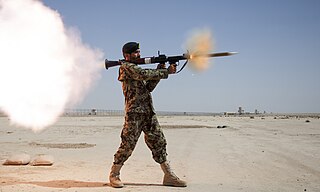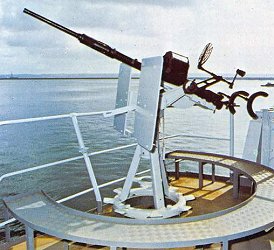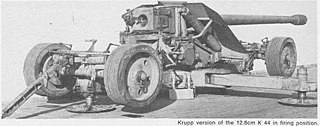
A recoilless rifle (rifled), recoilless launcher (smoothbore), or simply recoilless gun, sometimes abbreviated to "RR" or "RCL" is a type of lightweight artillery system or man-portable launcher that is designed to eject some form of countermass such as propellant gas from the rear of the weapon at the moment of firing, creating forward thrust that counteracts most of the weapon's recoil. This allows for the elimination of much of the heavy and bulky recoil-counteracting equipment of a conventional cannon as well as a thinner-walled barrel, and thus the launch of a relatively large projectile from a platform that would not be capable of handling the weight or recoil of a conventional gun of the same size. Technically, only devices that use spin-stabilized projectiles fired from a rifled barrel are recoilless rifles, while smoothbore variants are recoilless guns. This distinction is often lost, and both are often called recoilless rifles.

High-explosive anti-tank (HEAT) is the effect of a shaped charge explosive that uses the Munroe effect to penetrate heavy armor. The warhead functions by having an explosive charge collapse a metal liner inside the warhead into a high-velocity shaped charge jet; this is capable of penetrating armor steel to a depth of seven or more times the diameter of the charge. The shaped charge jet armor penetration effect is purely kinetic in nature; the round has no explosive or incendiary effect on the armor.

The Panzerfaust was a development family of single-shot man-portable anti-tank systems developed by Nazi Germany during World War II. The weapons were the first single-use light anti-tank weapons based on a pre-loaded disposable launch tube, a weapon configuration which is still used today.

A shell, in a modern military context, is a projectile whose payload contains an explosive, incendiary, or other chemical filling. Originally it was called a bombshell, contrasting with solid shells used for early rifled artillery, but "shell" has come to be unambiguous in a military context. A shell can hold a tracer.

Shoulder-fired missile, shoulder-launched missile or man-portable missile, among other variants, are common slang terms to describe high-caliber shoulder-mounted weapons systems; that is, weapons firing large, heavy projectiles ("missiles"), typically using the backblast principle, which are small enough to be carried by a single person and fired while held on one's shoulder. The word "missile" in this context is used in its original broad sense of a heavy projectile, and encompasses all shells and rockets, guided or unguided. A more formal variant is simply shoulder-fired weapons system and the like.

The V-3 was a German World War II large-caliber gun working on the multi-charge principle whereby secondary propellant charges are fired to add velocity to a projectile. It was built in tunnels and was permanently aimed at London, England.

Schwerer Gustav was a German 80-centimetre (31.5 in) railway gun. It was developed in the late 1930s by Krupp in Rügenwalde as siege artillery for the explicit purpose of destroying the main forts of the French Maginot Line, the strongest fortifications in existence at the time. The fully assembled gun weighed nearly 1,350 tonnes and could fire shells weighing 7 t to a range of 47 km (29 mi).

The Gyrojet is a family of unique firearms developed in the 1960s named for the method of gyroscopically stabilizing its projectiles. Rather than inert bullets, Gyrojets fire small rockets called Microjets which have little recoil and do not require a heavy barrel or chamber to resist the pressure of the combustion gases. Velocity on leaving the tube was very low, but increased to around 1,250 feet per second (380 m/s) at 30 feet (9.1 m). The result is a very lightweight and transportable weapon.

The HS.404 is an autocannon originally designed by and produced by the Swiss arm of the Spanish/Swiss company Hispano-Suiza in the mid-1930s. Production was later moved to the French arm of Hispano-Suiza.

The Oerlikon 20 mm cannon is a series of autocannons based on an original German Becker Type M2 20 mm cannon design that appeared very early in World War I. It was widely produced by Oerlikon Contraves and others, with various models employed by both Allied and Axis forces during World War II. Many versions of the cannon are still used.
The Sondergerät SG 500 Jagdfaust or Jägerfaust was an experimental airborne anti-bomber recoilless rifle designed for use in the Me 163 Komet rocket plane by the German Luftwaffe during World War II.

Wunderwaffe is a German word meaning "wonder-weapon" and was a term assigned during World War II by Nazi Germany's propaganda ministry to some revolutionary "superweapons". Most of these weapons however remained prototypes, which either never reached the combat theater, or if they did, were too late or in too insignificant numbers to have a military effect. The V-weapons, which were developed earlier and saw considerable deployment, especially against London and Antwerp, trace back to the same pool of highly inventive armament concepts. In the German language, the term Wunderwaffe now generally refers to a universal solution which solves all problems related to a particular issue, mostly used ironically for its illusionary nature.

The Flak 30 and improved Flak 38 were 20 mm anti-aircraft guns used by various German forces throughout World War II. It was not only the primary German light anti-aircraft gun but by far the most numerously produced German artillery piece throughout the war. It was produced in a variety of models, notably the Flakvierling 38 which combined four Flak 38 autocannons onto a single carriage.

The 12.8 cm Pak 44 is a German anti-tank gun used during World War II. It was designed as a result of experiences on the Eastern front in 1943. The German Army came upon the Soviet 122 mm field guns and issued a requirement for a similar weapon. Development initially concentrated on a field gun known as the Kanone K 44. However, once heavier Soviet tanks such as the IS-2 started to appear, the design requirements were altered to include an anti-armour role.

The PAW 600 was a lightweight anti-tank gun that used the high-low pressure system to fire hollow charge warheads. In 1945, it was used operationally by the Wehrmacht in small numbers. Only about 260 were produced before the war's end.

The 21 cm Nebelwerfer 42 was a German multiple rocket launcher used in the Second World War. It served with units of the Nebeltruppen, the German equivalent of the American Chemical Corps. Just as the Chemical Corps had responsibility for poison gas and smoke weapons that were used instead to deliver high-explosives during the war so did the Nebeltruppen. The name "Nebelwerfer" is best translated as "Smoke Mortar". It saw service from 1942–45 in all theaters except Norway. It was adapted for aerial combat by the Luftwaffe in 1943.
The high–low system is a design of cannon and anti-tank warfare launcher using a smaller high-pressure chamber to store propellant. It allows a much larger projectile to be launched without the heavy equipment usually needed for large caliber weapons. When the propellant is ignited, the higher pressure gases are bled out through vents at reduced pressure to a much larger low pressure chamber to push a projectile forward. The high-low system allows the weight of the weapon and its ammunition to be reduced significantly. Production cost and time are drastically lower than for standard cannon or other small-arm weapon systems firing a projectile of the same size and weight. It has a far more efficient use of the propellant, unlike earlier recoilless weapons, where most of the propellant is expended to the rear of the weapon to counter the recoil of the projectile being fired.

The 8.8 cm SK C/35 was a German naval gun used in World War II.

The AT4 is a Swedish 84 mm (3.31 in) unguided, man-portable, disposable, shoulder-fired recoilless anti-tank weapon manufactured by Saab Bofors Dynamics. The AT4 is not a rocket launcher strictly speaking, because the explosive warhead is not propelled by a rocket motor. Rather, it is a smooth-bore recoilless gun. Saab has had considerable sales success with the AT4, making it one of the most common light anti-tank weapons in the world. The M136 AT4 is a variant used by the United States Army.

The 20 cm naval rocket launcher was a rocket artillery system used by the Imperial Japanese Navy in the final stages of World War II.


















